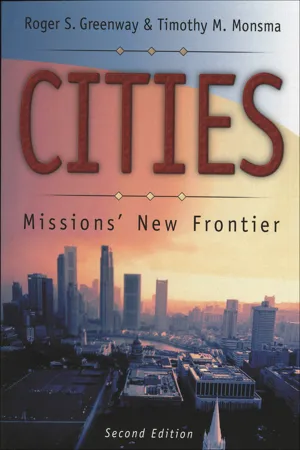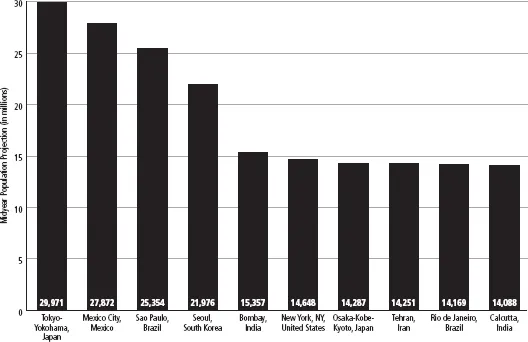
- 280 pages
- English
- ePUB (mobile friendly)
- Available on iOS & Android
eBook - ePub
About this book
As cities continue to expand, Christ calls the church to bring the gospel to these centers of population, culture, and political power.
Frequently asked questions
Yes, you can cancel anytime from the Subscription tab in your account settings on the Perlego website. Your subscription will stay active until the end of your current billing period. Learn how to cancel your subscription.
At the moment all of our mobile-responsive ePub books are available to download via the app. Most of our PDFs are also available to download and we're working on making the final remaining ones downloadable now. Learn more here.
Perlego offers two plans: Essential and Complete
- Essential is ideal for learners and professionals who enjoy exploring a wide range of subjects. Access the Essential Library with 800,000+ trusted titles and best-sellers across business, personal growth, and the humanities. Includes unlimited reading time and Standard Read Aloud voice.
- Complete: Perfect for advanced learners and researchers needing full, unrestricted access. Unlock 1.4M+ books across hundreds of subjects, including academic and specialized titles. The Complete Plan also includes advanced features like Premium Read Aloud and Research Assistant.
We are an online textbook subscription service, where you can get access to an entire online library for less than the price of a single book per month. With over 1 million books across 1000+ topics, we’ve got you covered! Learn more here.
Look out for the read-aloud symbol on your next book to see if you can listen to it. The read-aloud tool reads text aloud for you, highlighting the text as it is being read. You can pause it, speed it up and slow it down. Learn more here.
Yes! You can use the Perlego app on both iOS or Android devices to read anytime, anywhere — even offline. Perfect for commutes or when you’re on the go.
Please note we cannot support devices running on iOS 13 and Android 7 or earlier. Learn more about using the app.
Please note we cannot support devices running on iOS 13 and Android 7 or earlier. Learn more about using the app.
Yes, you can access Cities by Roger S. Greenway,Timothy M. Monsma in PDF and/or ePUB format, as well as other popular books in Theology & Religion & Christian Ministry. We have over one million books available in our catalogue for you to explore.
Information
1
The Urbanization of Our World
Timothy M. Monsma
My parents were born during the last decade of the nineteenth century, in “horse and buggy days.” When my mother was a teenager living on an Iowa farm, someone in the house shouted, “An automobile is coming down the road!” Everyone in the house ran outside to see what they had never seen before: a strange contraption sputtering down the road of its own accord with no horse pulling it!
When my mother died at 100 years of age, she was living in a world of freeways, airplanes, television, computers, and trips into space, with still newer and amazing inventions waiting on the drawing boards. To a greater or lesser extent, the entire world participated in the explosion of technology and inventiveness that took place during the twentieth century.
Along with the explosion of technology and a rapid increase of population came the explosive growth of cities. Here are quotes taken from World Urbanization Prospects published by a United Nations agency in 1998:
It is projected that just after the turn of the millennium, in a few years, for the first time in history urban dwellers will outnumber those in traditional rural areas . . . By 2006, half of the world population are expected to be urban dwellers. (p. 2) The urban population is growing three times faster than its rural counterpart. By 2030, three of every five persons will be living in urban areas. (p. 29)[1]
Figure 1
Top 10 Most Populous Cities 2000

More people now live in cities than in rural areas. By 2025, over two-thirds of the world’s population will be urban dwellers compared with one-third as recently as 1975. Ninety percent of this growth will take place in the Southern World. At the beginning of the 20th century, there were only 11 cities worldwide with over 1 million inhabitants. Now there are over 300. By 2025, according to the U.N. Habitat II Conference, there will be 570.
George Thomas Kurian, The Illustrated Book of World Rankings (Armonk, NY: M.E. Sharpe Inc., 1997), 343.
The giant cities of today’s world would not be possible without tremendous technological advances. It is surprising, therefore, that some of the largest metropolitan areas in our world today are located in some of the least developed areas. And some of these cities have grown in spite of extensive and chronic unemployment.
In this chapter we will briefly review the reasons for urban development and look at the fifteen largest cities of the world with their prospects for continued growth. This will be followed by some of the implications for Christian missions during the twenty-first century.
The Dynamics of Urbanization
What is the reason for the origin and growth of cities? In other words, what is the reason for this process that we call “urbanization”?
Cities are centers of service and dominance. That is to say, cities arise and grow because they serve the towns, villages, and farms that surround them. This activity takes various forms; some cities emphasize one more than the others. As a city grows larger, however, it tends to serve and influence its hinterland in at least eight major areas. People who live in towns and villages expect cities to render these services and would be disappointed if cities failed to provide them. Note that each of these services requires personnel to run them, and therefore each contributes to urban growth.
1. Government. Many ancient cities began as centers of government. All modern nations need not only national capitals, but, if they are large enough, regional capitals as well. These capitals cover all people, whether they live on the farm or in the city.
2. Education. We are all familiar with university towns. Most schools of higher education are in cities, which offer libraries, part-time work for students, and easy access from the surrounding area. This is especially important in the developing world, where people rely more heavily on public transportation than they do in the West.
3. Health care. A big hospital can usually give more extensive medical care, including surgery, than a small hospital. Big, diversified hospitals are found in large cities. This is especially true in the developing world. Throughout the world, therefore, the health care industry promotes urbanization.
4. Information. People, even those who are illiterate, want to be informed about the world, and especially about their own nation. Information is provided by radio, television, newspapers, magazines, and books. All these avenues of information originate in the city. The sphere of influence of a given city often extends as far as its radio waves. Radio and television place virtually everyone in immediate contact with the city. Nowadays, at least one radio can be found in most every village, no matter how remote.
5. Entertainment. Whether it’s through the fine arts, museums, popular music, sports, movies, or eating out, people go to the city to enjoy themselves. They expect the city to provide this type of cultural leadership. With the help of radio and television, sports events that originate in the city are enjoyed by people in towns and rural areas for many miles around. The entertainment industry helps cities to grow.
6. Trade. In the days when people were more dependent on shipping goods by water than we are today, cities grew by the riverside or where there were deep harbors. Later, cities grew where railroad lines and roads intersected. Now airports (or the lack thereof) affect urban growth. Commerce and the transportation that it involves contribute mightily to the growth of cities.
7. Industry. Manufacturing has given tremendous impetus to the growth of Western cities and some cities of the developing world. It is surprising, therefore, when cities having minimal manufacturing nonetheless achieve world-class status (a population of at least one million and direct ties with the world beyond its national borders). Remember, however, that there were large cities in the ancient world, including China and India, long before industrialization took place. The chapter in this book on shantytowns helps explain why some cities grow large even without extensive industrialization.
8. Warfare. Some cities began as military camps. This is the history of Ibadan in Nigeria and Pittsburgh in Pennsylvania, not to mention all cities whose name begins with “Fort.” The need to set up military camps and defense plants encourages urbanization ...
Table of contents
- Cover
- Title Page
- Copyright Page
- Dedication
- Contents
- Preface to the First Edition
- Preface to the Second Edition
- 1. The Urbanization of Our World
- 2. A Biblical Framework for Urban Missions
- 3. The Urban-Mission Movement in the New Testament
- 4. Antioch: A Biblical Model of Urban Church Development
- 5. Evangelism, Relief, and Development
- 6. The Ends of the Earth Have Come to Town
- 7. Barriers to Reaching Urban Ethnics
- 8. Goals of Urban Ethnic Evangelism
- 9. A Model of Church-Centered Ethnic Outreach
- 10. The Intersecting Veins of the City
- 11. Research: Matching Goals and Methods to Advance the Gospel
- 12. The Stages of Church Development
- 13. The Pros and Cons of Church Buildings
- 14. The Urban Poor in “Christian” America
- 15. Ministering to Street People
- 16. Children at Risk in Cities
- 17. Ministry in the Red-Light District
- 18. Ministry in Shantytowns
- 19. Raising a Family in the City by Choice
- 20. Pastoring in the City
- 21. Violence, Injustice, and Church-State Relationships
- Notes
- Bibliography
- Subject Index
- About the Authors
- Other Books by Authors